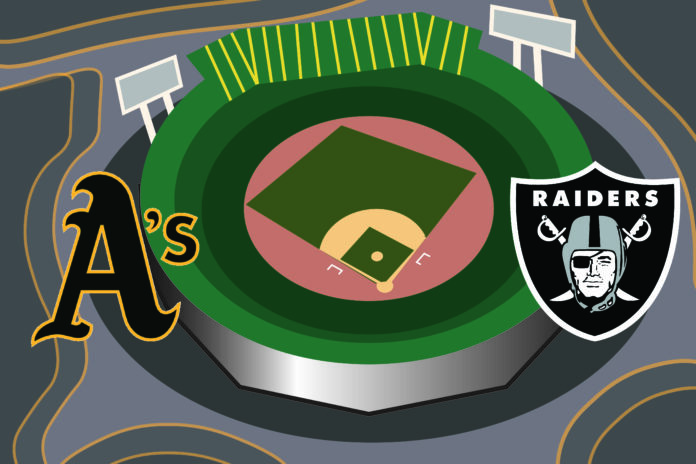A’s are last hope as city prepares to say goodbye to Warriors, Raiders
For the last 60-plus years, the property nestled between 66th Avenue and Hegenberger, just on the side of the Nimitz Freeway, has housed a trio of proud sports franchises. Three teams, the A’s, Raiders and Warriors, not only brought a lifetime full of memories and championships, but truly embodied the scrappy, resilient nature of the city they call home.
Fast forward to 2019, where two-thirds of its inhabitants will be departing in the span of six months.
The Warriors are playing their final games at Oracle Arena in the NBA Finals before bolting to the other side of the bay. Ever since co-owners Joe Lacob and Peter Guber took control of the Warriors in 2010, they had their sights set on a new arena in San Francisco. After a few setbacks, the team finally settled on a location in the Mission Bay district, about one mile south of the San Francisco Giants’ Oracle Park. The new $1 billion Chase Center, which will seat 18,064 fans, will open in September, in time for the 2019-2020 season.
The Raiders are in the midst of their second divorce with the city of Oakland. After abandoning the area for a move to Los Angeles in the early 1980s and subsequently returning 12 years later, the Silver and Black are now in a position to relocate to Las Vegas in the fall of 2020. The team has secured an unfathomable $750 million in public money from Nevada taxpayers, paving the way for a $1.8 billion stadium that will seat 65,000 fans.
At the end of the day, the city of Oakland was simply not in a position to shell out any amount of tax dollars to finance new venues for its sports teams, especially given the regrettable decisions made in the late 1990s that funded two major renovations to the Oakland Coliseum and Oracle Arena.
Fortunately for Oakland and its citizens, the Warriors have been mandated to pay off the remaining $40 million in debt for the renovations to Oracle Arena. Oakland and the Raiders are currently in a legal battle to determine who will cut the check for the almost $80 million in debt from the Coliseum upgrades, which were a key factor in the Raiders’ decision to return from Los Angeles.
After nearly 15 years of aimless stadium searches and relocation threats, it seems the Athletics finally have a path to securing a new stadium, and one that allows them to be the last remaining professional sports franchise in Oakland.
The team’s 51-year stay in the Oakland Coliseum became progressively worse in recent decades, especially since the return of the Oakland Raiders in 1996 and the subsequent renovations and construction of “Mount Davis.” This monstrous seating area high above center field blocks what used to be a picturesque view of the Oakland hills behind the stadium and serves no purpose for the A’s, who kept tarps over those seats for many years.
The A’s have tried to move to locations such as Fremont and San Jose in the last 20 years and threatened to relocate out of the Bay Area entirely but are now finally committed to staying in Oakland.
Things took a turn for the better in late 2016 when former co-owner Lew Wolff decided to step down and current team president Dave Kaval was hired. Kaval, who oversaw the building of the San Jose Earthquakes’ Avaya Stadium, has been at the forefront of the team’s pursuit of a new ballpark in Oakland.
In the fall of 2017, the A’s originally announced their intentions to build a stadium in the Peralta Community College District in downtown Oakland, near Laney College and the city’s Chinatown neighborhood. The team went all in on this idea and seemed convinced it would work out, so the backlash from organizations in the area and the community college came as quite an embarrassment for Kaval and the A’s.
With the downtown location firmly out of the picture, the A’s currently have two options for locations to build their ballpark: the current Coliseum property or a 50-acre site known as “Howard Terminal” in the Port of Oakland.
Currently, Howard Terminal is the team’s preferred option, due to its proximity to the waterfront and Jack London Square, an adjacent area with many restaurants, shops, offices and new housing developments. The team hopes to construct a 35,000-seat stadium that will be ready to open in time for the 2023 season.
Out of the three original options, Howard Terminal poses by far the most challenges. The site has been used for industrial purposes for many decades in the Port of Oakland and likely contains a variety of toxic and hazardous materials. Before the A’s can even come to an agreement to purchase the property or break ground, they will need to conduct many Environmental Impact studies and possibly conduct a large-scale cleanup. In addition, there has been a considerable amount of pushback from Port workers and longshoremen who believe the project will negatively affect their businesses and take away jobs.
Finally, there are concerns regarding the ability of this neighborhood to handle the increased traffic and influx of thousands of fans on a daily basis. The A’s will have to find a solution to these transportation issues and a way to provide the appropriate amount of parking spaces and public transportation options in an area that currently cannot handle such demands.
Nevertheless, the A’s received a vote of confidence earlier this month from the Port of Oakland’s board of commissioners, who gave the team a four-year period to do all necessary preparatory work on the project including conducting environmental studies and obtaining “land-use” permits. Just last week, the California State Assembly approved a bill outlining the team’s plans to construct the privately-financed stadium. Needless to say, the last few weeks provided a lot of optimism that the A’s will finally figure things out.
It’s no secret that the A’s have struggled to draw fans to their ancient, dilapidated home, annually sporting some of the lowest attendance numbers in Major League Baseball. Even so, the old concrete bowl in East Oakland doesn’t deserve all of the blame for these problems.
Over the last couple decades, the A’s frugal ownership group repeatedly neglected to reinvest in the team and spend the necessary dollars to sign players to long-term contracts and build for an extended run of success. Even though the team has been quite successful during this time, especially given its miniscule payroll, the front office routinely opted for fire sales of the team’s best players, so the most promising and exciting talent has been traded away to other teams.
This painful practice truly took a toll on the fanbase over the last two decades, leading to dwindling fan support at the box office and general outrage from many supporters. Many fans feel betrayed when their favorite players are traded away in the peak of their careers. From a fan’s perspectives, the loyalty they show in the stands is not matched by the team’s front office.
A’s fans in the East Bay show time and time again how passionate and supportive they can be and simply need a reason to believe that the organization cares as much as they do about delivering a winning product on the field.
The A’s took the first step towards changing their ways with the recent signing of slugger Khris Davis to a multiyear contract. Fans hope young cornerstone players Matt Chapman and Matt Olson will receive similar treatment in the near future.
Besides spearheading the efforts for a new stadium, Kaval has attempted to reinvigorate the A’s fanbase with numerous improvements to the existing fan experience at the Oakland Coliseum. Over the past two seasons, the team introduced a plethora of new seating areas around the stadium and a revolutionary and affordable ticketing framework. For the first time in a while, the organization is making an effort to engage its fans.
While a new ballpark would help boost interest in the A’s and drive up revenues for the team, a development like this won’t suddenly solve all of the organization’s business problems. There are too many years of distrust built up among much of the fanbase. This fractured relationship will not be repaired overnight, even with the prospect of a sparkling new stadium.
In order for the team to achieve long-term, sustainable success in Oakland, it must prove to its fans that it’s committed to spending the necessary amount of money to keep its star players on the roster for many years at a time and truly develop a core capable of competing for championships the fans can support.
Whether the Howard Terminal project pans out or the A’s end up staying at the Coliseum site, it is refreshing and encouraging to see team executives who show they care about the fans and are committed to keeping the team in Oakland.
It’s been a rough few years for East Bay sports fans and the next six months are only going to get tougher with the departure of the Raiders and Warriors. But there may be light at the end of the tunnel.
If the A’s can finally put an end to their lengthy stadium dilemma, at least Oakland fans will have one team playing in town for 81 days out of the year.
Written by: Brendan Ogburn — sports@theaggie.org




